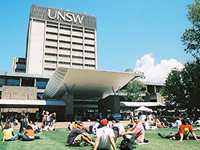|
|||||||||||||||||||||||||||||||||||||||||
| Software Engineering - 3648 | |||||||||||||||||||||||||||||||||||||||||

Software Engineering is an Engineering profession concerned with the processes, methods, and tools for the design and development of high quality, reliable software systems. This involves the study and application of software specification, design, implementation, testing, and documentation of software. Target systems may range from simple software applications to mission-critical real-time systems.
The stages of the program are shown below. It should be noted that it is possible to adapt the program by moving courses, subject to prerequisite requirements. Note: The School also offers the dual degrees
BE(Software Eng)/BSc program 3651, BE(Software Eng)/BA program 3704, BE(Software Eng)/BCom program3653, BE(SoftwareEng)/MBiomedE program3749 Program Objectives and Graduate Attributes Please see Rules
Year 1
And ONE of:
And ONE of:
Year 2
Year 3
Year 4
Electives
The 8 electives (48 UOC) for stages 3 and 4 may include any third and fourth stage COMP, INFS and 3rd year MATHS courses. Electives and more information can be found at www.cse.unsw.edu.au/seng. General Education Requirements Please see Rules
Please see Rules
Please see Rules
For information regarding fees for UNSW programs, please refer to the following website: https://my.unsw.edu.au/student/fees/FeesMainPage.html
Industrial Training Requirements All students in the BE in Computer Engineering, Bioinformatics Engineering and Software Engineering programs must complete at least 60 days of approved Industrial Training before the end of Year 4.
Further Information and Requirements Some courses listed here also offer advanced versions
Computing Requirements
Information regarding recommended computing equipment and software for the program is available from the School of Computer Science and Engineering Help Desk.
Engineers Australia
The professional body for engineering in Australia is Engineers Australia, which has as its first objective the promotion of the science and practice of engineering in all its branches. Engineers Australia has its national headquarters in Canberra and functions through a series of divisions, the local one being the Sydney Division. Within each division are branches representing the main interests within the profession, e.g. civil, mechanical, electrical, engineering management and environmental engineering. Students of an approved school of engineering may join the Institution as a student member (StudIEAust). Student members receive the monthly publication Engineers Australia and for a small fee they also receive The Transactions which contains articles on a particular branch of engineering. Student members are invited to participate in the Excellence Award for Work Experience, the National Young Engineer of the Year Award and to avail themselves of other Engineers Australia services including the Mentor Scheme and industrial experience guidance. For more information and membership application forms, contact Engineers Australia, Sydney Division, Level 3, 8 Thomas Street, CHATSWOOD NSW 2067 - telephone 02 9410 5600 www.engineersaustralia.org.au The Australian Computing Society The peak professional body for computing in Australia is the Australian Computing Society (ACS) - www.acs.org.au The objectives of the ACS can be found here and include: "advanc[ing] professional excellence in information and communications technology, and further[ing] the study, science and application of information and communications technology." Again, students who want to join ACS should go to Member Application Area(s) of Specialisation |
|||||||||||||||||||||||||||||||||||||||||


